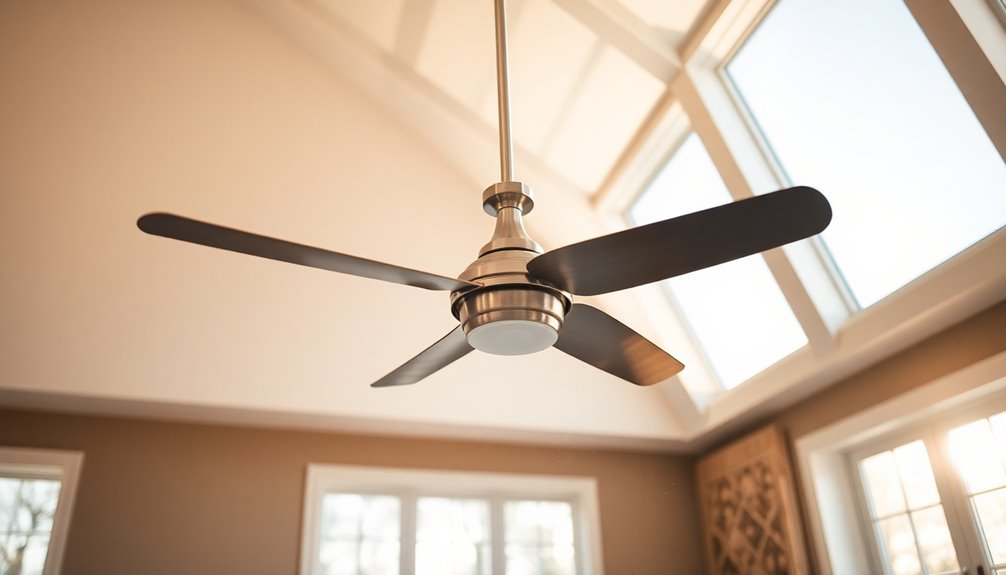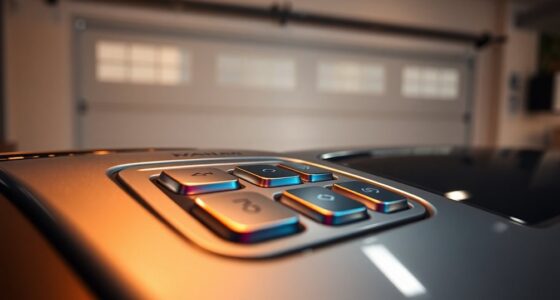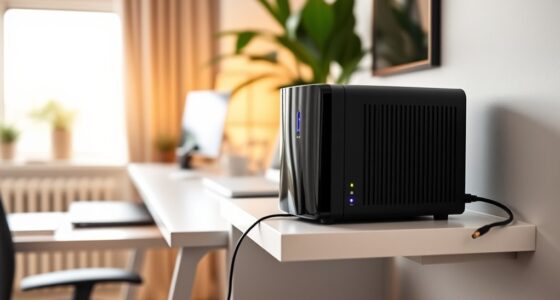Ceiling fans have a reverse function that works wonders for your comfort and energy efficiency. In the summer, running your fan counterclockwise creates a cooling breeze, helping you rely less on air conditioning. Come winter, switching to clockwise redistributes warm air that can get trapped near the ceiling, keeping your space cozy. These seasonal adjustments can save you up to 30% on cooling costs and about 15% on heating. Making the switch isn't complicated, and it can boost overall room temperature consistency. Want to discover even more ways to maximize your fan's benefits? Stick around!
Key Takeaways
- Ceiling fans can reverse direction to provide cooling in summer and warmth in winter, enhancing comfort year-round.
- Counterclockwise rotation reduces air conditioning reliance, potentially lowering cooling costs by up to 30%.
- Clockwise rotation redistributes warm air, improving HVAC efficiency and reducing heating costs by about 15%.
- Regularly changing fan direction maximizes airflow efficiency, ensuring consistent room temperatures and eliminating hot spots.
- Proper fan size and direction complement air purifiers, improving overall indoor air quality and energy efficiency.
Benefits of Ceiling Fan Reversal

When you reverse your ceiling fan's direction, you open up a range of benefits that can enhance your home's comfort and energy efficiency.
In the summer, setting your ceiling fan blades to spin counterclockwise creates a cooling effect, promoting better air circulation and reducing your reliance on air conditioning. This could lower your energy bills considerably.
In winter, reversing your ceiling fans to a clockwise direction redistributes warm air trapped near the ceiling, helping maintain an even temperature throughout your space.
Regularly adjusting fan direction maximizes airflow efficiency, eliminating hot spots and ensuring consistent comfort. Additionally, this practice can complement the use of air purifiers to improve overall air quality in your home.
Energy Savings With Proper Rotation

When you adjust your ceiling fan's rotation seasonally, you can considerably cut energy costs.
A counterclockwise spin in the summer helps you feel cooler, allowing you to raise your thermostat, while a clockwise rotation in winter redistributes warm air, improving HVAC efficiency.
These simple changes not only enhance your comfort but also save you money on your energy bills.
Lower Energy Costs
Properly rotating your ceiling fan can lead to significant energy savings, with potential reductions in air conditioning costs by up to 30% during summer months.
By using the reverse switch correctly, you can maximize air movement and enjoy the wind chill effect, allowing you to set your thermostat higher without sacrificing comfort.
Here's how to achieve lower cooling bills:
- Set temperature higher: Increase your thermostat setting by 4°F.
- Run counterclockwise: Use the reverse switch for summer airflow.
- Optimize winter use: Switch to clockwise to redistribute warm air.
- Regular adjustments: Change fan direction with the seasons for maximum energy savings.
Using ceiling fans effectively not only cuts costs but also enhances your comfort throughout the year.
Enhanced HVAC Efficiency
Adjusting your ceiling fan's rotation can dramatically enhance HVAC efficiency and lead to significant energy savings. By setting your fan to counterclockwise in summer, you can raise your thermostat by 4°F without sacrificing comfort, reducing air conditioning reliance by up to 30%. In winter, reversing the fan to clockwise circulates warm air, potentially lowering heating costs by 15%. This proper fan rotation improves airflow, ensuring a consistent temperature throughout the room and reducing the workload on your heating and cooling systems. Additionally, modern Energy Star certified fans are designed to maximize energy efficiency, further contributing to cost savings.
| Season | Fan Direction | Benefits |
|---|---|---|
| Summer | Counterclockwise | Reduces AC reliance by 30% |
| Winter | Clockwise | Lowers heating costs by 15% |
| Year-round | Correct usage | Enhances overall efficiency |
| Improves air distribution | ||
| Saves long-term energy |
Seasonal Temperature Control
To maximize energy savings and comfort in your home, understanding how to regulate ceiling fan rotation with the changing seasons is essential.
Adjusting your ceiling fans to the correct direction can greatly impact your energy bills.
- Summer: Run ceiling fans to counter-clockwise for cooling, allowing you to set your thermostat higher.
- Winter: Switch fans to clockwise to reverse the flow, redistributing warm air throughout the room.
- Air Circulation: Proper fan rotation enhances air circulation, reducing reliance on heating and cooling systems.
- Energy Savings: Seasonal adjustments can lead to savings of up to 30% in summer and 15% in winter. Additionally, using ceiling fans in conjunction with energy-efficient systems can further amplify energy savings and comfort in your home.
How to Change Fan Direction
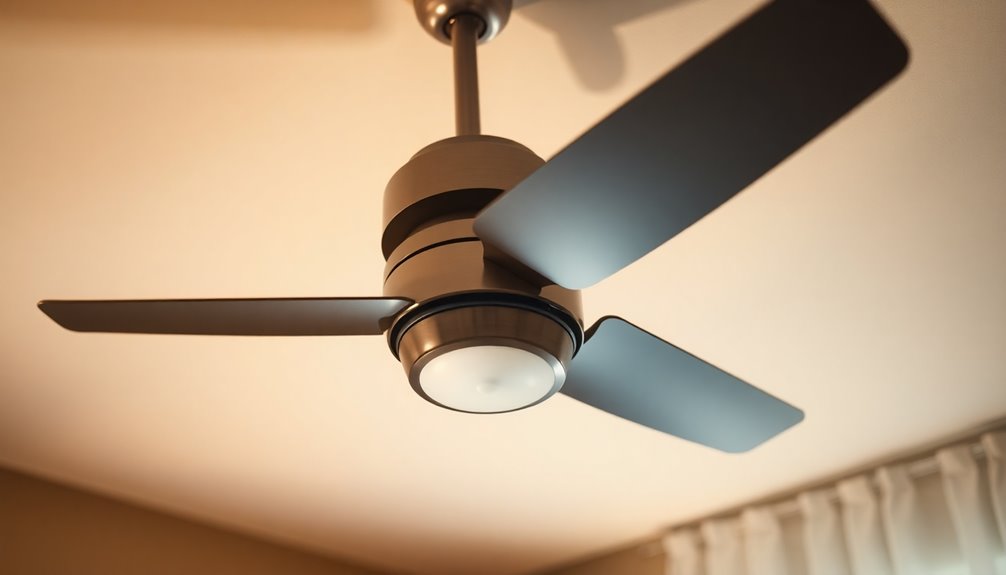
Changing the direction of your ceiling fan is a straightforward process that can enhance your comfort year-round.
Start by turning off the fan and waiting for the blades to stop completely for safety. Locate the reverse switch, which is usually found on the fan body, near the light kit, or on the remote control.
Flip the switch to change the fan's direction from counterclockwise rotation in summer to clockwise rotation in winter. This seasonal change maximizes energy efficiency and guarantees ideal performance.
For best results, check that the blades are angled between 12 to 16 degrees. Always consult your manufacturer's instructions, as mechanisms may vary between models, ensuring you get the most out of your ceiling fan.
Importance of Fan Size
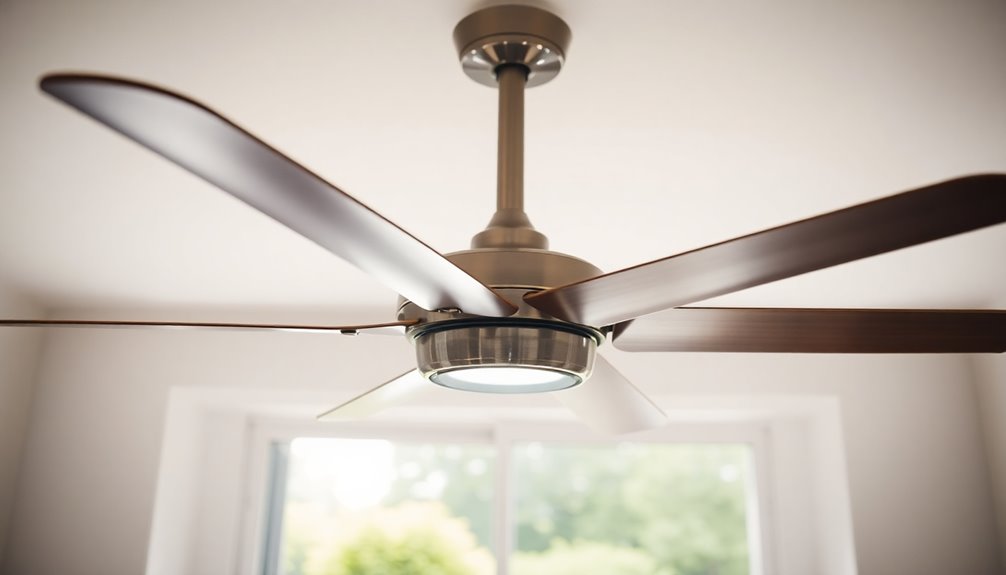
Selecting the right size ceiling fan plays a significant role in your home's comfort and energy efficiency.
Here's why fan size matters:
- Optimal Air Circulation: A properly sized fan enhances airflow, ensuring effective cooling or heating.
- Temperature Distribution: Correct sizing promotes even temperature distribution throughout the room.
- Energy Efficiency: Avoid energy waste by preventing oversized fans from creating excessive airflow or undersized fans from overworking.
- Ceiling Height Consideration: Fans should be at least 7 feet above the floor to maximize airflow and comfort.
Seasonal Adjustments for Comfort
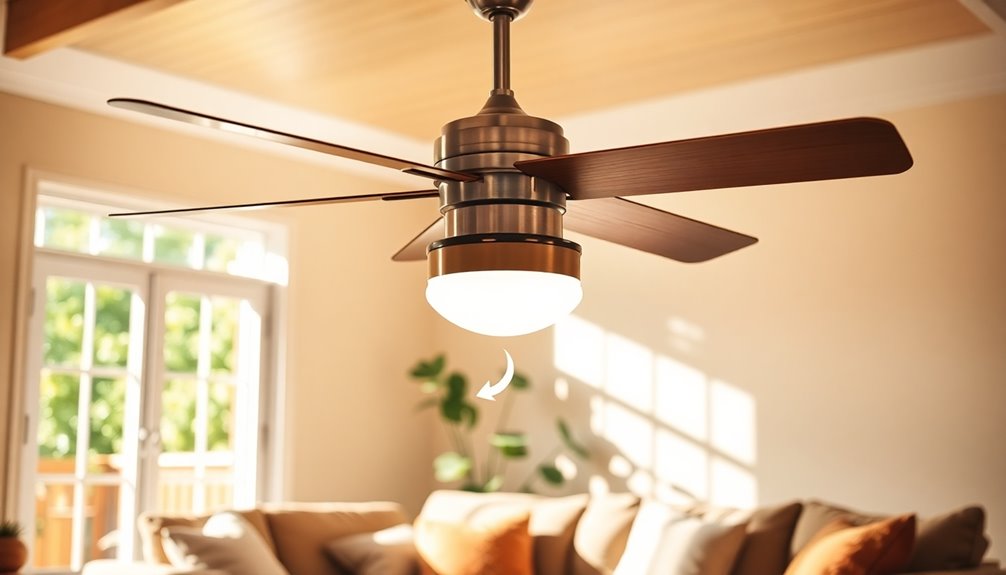
When you adjust your ceiling fan's direction with the changing seasons, you enhance your home's comfort and energy efficiency.
In summer, set your ceiling fan to rotate counterclockwise. This creates a breeze and a wind-chill effect, allowing you to feel more comfortable while raising your thermostat up to 4°F. You'll save up to 30% on cooling costs!
During winter, switch it to clockwise to promote downward airflow. This helps circulate warm air that heat rises to the ceiling, maintaining a consistent temperature and reducing heating costs by around 15%.
Regular seasonal adjustments guarantee ideal air circulation and comfort, and setting reminders during Daylight Savings Time makes it easy to stay on track with energy efficiency year-round.
Advanced Features of Ceiling Fans

As technology evolves, ceiling fans have become smarter and more efficient, offering advanced features that enhance your comfort and convenience.
Here are some key innovations to look for:
- Remote Control: Easily switch between forward and reverse modes without manual adjustments.
- Smart Technology: Automated direction adjustments based on seasonal changes boost energy efficiency.
- Variable Blade Pitch: This feature maximizes airflow, allowing the fan to push air upward or downward as needed.
- Built-in Sensors: Detect room temperature and humidity, automatically adjusting speed for ideal comfort.
With these advanced features, you can enjoy improved energy efficiency and a more comfortable living environment, making modern ceiling fans a smart choice for any home.
Frequently Asked Questions
What Is the Point of Reversing a Ceiling Fan?
Reversing a ceiling fan changes its rotation direction, which can greatly impact your comfort.
During summer, you want it to spin counterclockwise to create a cooling breeze that helps you feel more comfortable without cranking up the air conditioning.
In winter, switching to clockwise allows the fan to circulate warm air that rises to the ceiling, keeping your space cozy.
This simple adjustment can enhance your comfort and potentially save you money on energy bills.
What Are the Benefits of a Reversible Ceiling Fan?
Imagine a cozy winter evening, where warmth envelops you like a soft blanket. A reversible ceiling fan enhances that comfort by circulating warm air downward.
In summer, picture a revitalizing breeze invigorating your space, allowing you to raise the thermostat and save on energy bills.
Is It Better to Reverse the Fan or Forward the Fan?
Deciding whether to reverse your fan or leave it running forward depends on the season.
In summer, you should run it counterclockwise for a revitalizing breeze, making you feel cooler.
During winter, reversing it to clockwise helps push warm air down, keeping your space cozy.
Adjusting the direction based on the season not only enhances your comfort but can also save you money on energy bills.
Which Way Should a Ceiling Fan Go to Cool Down a Room?
When the summer sun blazes, your ceiling fan should dance counterclockwise. This way, it pushes cool air down, creating a revitalizing breeze that makes you feel considerably cooler.
You can stand beneath it, watch the blades spin from right to left, and enjoy the wind-chill effect. By using this setting, you'll feel comfortable while saving on energy costs, allowing your thermostat to breathe a sigh of relief.
Conclusion
To sum up, reversing your ceiling fan isn't just a neat trick; it can save you up to 15% on your energy bills! By adjusting the fan's direction seasonally, you can stay comfortable year-round while reducing your reliance on heating and cooling systems. So, next time you're feeling too hot or too cold, remember that simple switch could make a big difference. Enjoy the benefits of your ceiling fan and keep your home cozy without breaking the bank!
